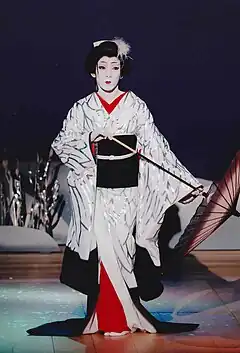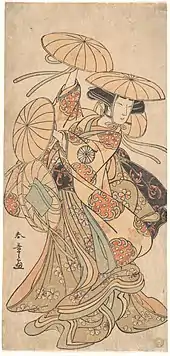Shosagoto
Shosagoto (所作事) or furigoto (振事), also known as dance or dance-drama, is a type of kabuki play based on dance.[1] It is one of the three genres of kabuki, together with jidaimono (historical plays) and sewamono (contemporary plays).

A central element of kabuki since its origin in 1603, shosagoto plays became an important part of the kabuki repertoire towards the end of the 17th century, and still forms a key part of the kabuki repertoire today. For example, the January 2018 program at the Kabuki-za in Tokyo included three shosagoto performances.[2]
There are several types of kabuki dances. An important difference is between the mainly non-narrative dances with nagauta accompaniment (such as Fuji Musume), and the more dramatic ones, with complex storylines and characters (such as Kanjinchō).[3] The nagauta musicians are often seated in rows on stepped platforms behind the dancers.[4] There are many other distinctions and styles. For example, matsubame mono dances include particularly theatricalized sets and costumes, often including quick on-stage changes of clothes (called hikinuki).[5][3] Hengemono dances involve a single actor playing different roles.[6]
History
From the very origin of kabuki in 1603, when Izumo no Okuni began performing in the dry riverbeds of Kyoto - a style referred to as okuni kabuki - dance has been a central element of kabuki, and in fact those first performances involved more dance and music than drama.[7][8]
An important early development of dance in kabuki was the incorporation of elements from keigoto, bunraku dance scenes.[7] However, proper shosagoto dances, performed by onnagata (lit. "female role") actors, entered the kabuki repertoire in the Genroku period (1688-1704) (see also Genroku bunka). The form was further developed from the Kyoho to the Horeki period (1716–1764), and nagauta became the main form of accompaniment.[9]
The first actor to perfect the genre was Segawa Kikunojo I (c. 1693–1749),[7] considered an excellent dancer and the best onnagata in Edo during the first half of the 18th century.[10] He became very successful shortly after arriving to the city in 1730 by performing the leading role on the dance Aioi Jishi at the Nakamura-za.[11] He specialized in the performance of Shakkyomono (such as Aioi jishi) and Dojojimono dances.[12] Some other important dance roles he performed in those early years were Sayo no Nakayama Asama-ga-Dake (1736), Mugen no Kane (1739), Hanabusa Shishi no Rangyoku and Makura Jishi (1742), and Mugen no Kane Omoi no Akatsuki (1746).[10]

Another important actor in the early development of onnagata shosagoto was Nakamura Tomijuro I (1719–1786), also said to have perfected kabuki dance.[13] A native of Osaka, he achieved great success early in his career with performances of a Shakkyomono dance, particularly in Edo at the Nakamura-za in 1741 and then again in 1748.[14] His greatest accomplishment was his performance of the main role in the debut of one of the most famous kabuki dances, Musume Dojoji, in 1753, again at the Nakamura-za.[15] The performance was so successful[16][14] that it was staged for several months, and Tomijuro became one of the most famous actors in Edo.[17]
References
- "Shosagoto in Kabuki Glossary". kabuki21. Retrieved 2017-10-03.
- "January at the Kabukiza Theatre". Kabuki Official Website. Retrieved 2017-12-27.
- Historical Dictionary of Japanese Traditional Theatre. (2006) p. 367-368.
- Leiter, Samuel L. (16 January 2006). Historical Dictionary of Japanese Traditional Theatre. Scarecrow Press. p. 115. ISBN 9780810865143.
- "Hikinuki in Kabuki Glossary". kabuki21. Retrieved 2017-10-03.
- "Hengemono in Kabuki Glossary". kabuki21. Retrieved 2017-10-03.
- Historical Dictionary of Japanese Traditional Theatre. (2006) p. 47-48.
- "What is Nihon Buyo?". Nihon Buyo. Retrieved 2017-10-03.
- "Development of Shosagoto". Invitation to Kabuki. Retrieved 2018-01-11.
- "Segawa Kikunojo I". kabuki21. Retrieved 2018-01-11.
- "Aioi Jishi". kabuki21. Retrieved 2018-01-11.
- "Development of Shosagoto". Invitation to Kabuki. Retrieved 2018-01-11.
- "Development of Shosagoto". Invitation to Kabuki. Retrieved 2018-01-11.
- "Nakamura Tomijuro I". kabuki21. Retrieved 2018-01-16.
- "Musume Dojoji". kabuki21. Retrieved 2018-01-16.
- "Development of Shosagoto". Invitation to Kabuki. Retrieved 2018-01-11.
- "Development of Shosagoto". Invitation to Kabuki. Retrieved 2018-01-11.